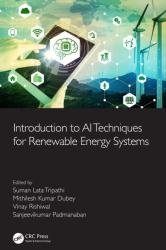 Название: Introduction to AI Techniques for Renewable Energy Systems
Название: Introduction to AI Techniques for Renewable Energy SystemsАвтор: Suman Lata Tripathi, Mithilesh Kumar Dubey
Издательство: CRC Press
Год: 2021
Страниц: 423
Язык: английский
Формат: pdf (true)
Размер: 25.4 MB
This book helps the undergraduate, graduate students and Academician to learn the concept of Artificial Intelligence techniques used in renewal energy with suitable real-life examples. Artificial intelligence (AI) techniques play an essential role in modeling, analysis, and prediction of the performance and control of renewable energy. The algorithms used to model, control, or predict performances of the energy systems are complicated involving differential equations, enormous computing power, and time requirements. Instead of complex rules and mathematical routines, AI techniques can learn critical information patterns within a multidimensional information domain. Design, control, and operation of renewable energy systems require a long-term series of meteorological data such as solar radiation, temperature, or wind data. Such long-term measurements are often non-existent for most of the interest locations or, wherever they are available, they suffer from several shortcomings (e.g. inferior quality of data, in-sufficient long series, etc.). For overcoming these problems, AI techniques appear to be one of the most substantial parts of the book. The book summarizes commonly used AI methodologies in renewal energy, with a particular emphasis on neural networks, fuzzy logic, and genetic algorithms. Book outlines selected AI applications for renewable energy. In particular, discusses methods using the AI approach for the following applications using suitable examples: prediction and modeling of solar radiation, seizing, performances, and controls of the solar photovoltaic (PV) systems.
This book is organized into 24 chapters in total.
Chapter 1 intends to study the brief introduction and past history relevant to artificial intelligence (AI) in fields of solar, wind, and other renewable energy sources.
Chapter 2 presents a study on issues and challenges of renewable energy and AI applications to resolve these issues.
Chapter 3 demonstrates the key challenges faced in renewable energy using machine learning and various AI applications in real-life scenarios.
Chapter 4 deals with enhanced computational power and hybrid transaction or analytical processing systems (HTAPS) enabling ML algorithms to optimize the energy and also the power sector on an outsized scale.
Chapter 5 highlights the importance of machine learning in research and development, and also focuses on its types and techniques.
Chapter 6 is designed to provide the ins and outs of hybrid renewable energy systems (HRESs) such as the configuration architecture, stability issues, maintenance, available optimization techniques, and performance predicting simulation software for HRESs.
Chapter 7 focuses mainly on the integration of solar photovoltaic (PV) and electricity board (EB) source for sustaining the electric power system to satisfy the energy demand throughout the adequate insolation.
Chapter 8 describes the various AI techniques and machine learning algorithms and how these approaches have been applied to different renewable energy (RE) types, especially solar energy.
Chapter 9 demonstrates the accuracy and effectiveness of the proposed optimizer; a 400-W domestic standalone SPV system and its specifications are used as a model for simulation in MATLAB.
Chapter 10 throws light on the various AI-based failure prediction strategies that are deployed on renewable source infrastructure.
Chapter 11 deals with the application of AI techniques in smart energy systems and is an effort to concise all the information on the optimization of solar energy systems for common-life applications.
Chapter 12 gives an idea about AI-enabled energy forecasting systems to handle fluctuations that may adversely affect the planning, designing, and operations according to the requirements...
Chapter 24 addresses the security issue in the smart grid due to large data processing and proposed machine learning-based cyber security solutions for the intelligent grid.
Скачать Introduction to AI Techniques for Renewable Energy Systems